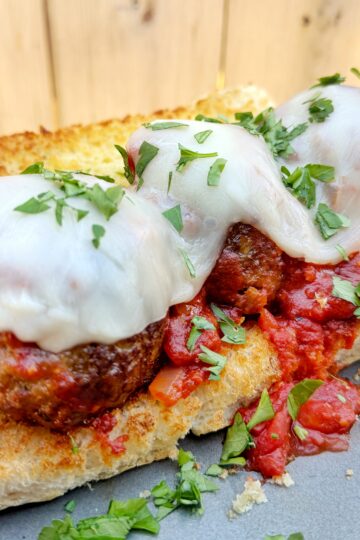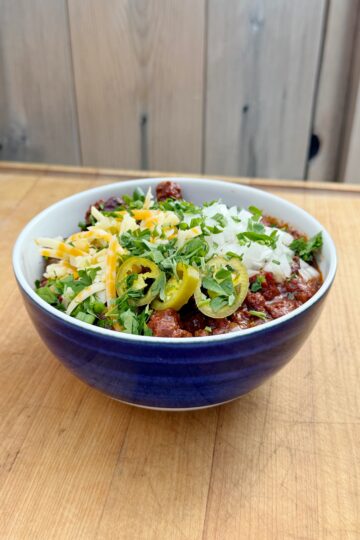Smoking a brisket is more than just cooking—it’s an art form. This smoked brisket recipe will guide you through the process of creating a tender, juicy, and flavorful masterpiece. Whether it’s your first attempt or you’re looking to improve, this guide will have you feeling confident and ready to tackle that 15 lb whole brisket. Let’s get started!
Print out a PERFECT Leftover Brisket Recipe - Brisket Cheese Ball!
Let’s Prep
Brisket comes from the chest of the cow, which means it’s a tough cut of meat loaded with connective tissue. That’s why low-and-slow cooking is the way to transform it into something incredible. A beef brisket is typically sold as a whole packer brisket, which includes the flat and the point. For the best results, head to your local butcher shops or grocery store and look for one with good marbling and a nice layer of fat.

Trimming is your first step. Use a very sharp knife to remove any hard layer of fat that won’t render during cooking, but leave about a ¼-inch of the fat cap side for moisture. Pat the meat dry with paper towels, then let it rest at room temperature while you prep the rub.

For the rub, keep it simple but effective. Combine kosher salt, coarse black pepper, garlic powder if you want. I've heard of people even adding a little brown sugar for sweetness, I don't do that. Coat the brisket generously on all sides, making sure every nook and cranny is covered. This layer will create the flavorful bark that makes brisket so irresistible.
Print out a PERFECT Leftover Brisket Recipe - Brisket Cheese Ball!
Let’s Cook
When it comes to the smoker, the type of smoker doesn’t matter as much as your ability to maintain a consistent low temperature between 225°F and 250°F. Use a water pan to help keep the environment moist and encourage a beautiful smoke flavor.

Place the brisket on the smoker with the fat side up. This way, the melting fat will baste the meat as it cooks. Keep a meat thermometer handy to monitor the internal temperature of the brisket. While the general rule of thumb is 1.5 hours per pound, it’s more about cooking to feel and temperature. For a 15-pound brisket, you’re looking at a long time—up to 20 hours. Your target? 203°F in the thickest part of the meat for the most tender meat.
Around the 6-hour mark, check the bark. You want it dark and firm, not soft or sticky. This is a good gauge of how your cook is going, you'll begin to see the outside fat cap start to crisp up slightly, this is good. If you don't see this, you know your brisket is taking a little longer to cook than normal - this is ok - just let it ride!

Continue to spritz your brisket when it begins to get dry on the outside. The water is important as it helps the smoke adhere to the outside of the meat building both flavor and color.
The Waiting Game
Here’s the truth: brisket is a test of patience. Maintaining that steady temperature for a long period of time is crucial. Avoid the temptation to peek too often, as every time you open the smoker, you let out precious heat. This part of the cooking process can feel like forever, but trust me, the payoff is worth it.
Once your meat thermometer reads 203°F in the thickest part, it’s time to start checking doneness. When a brisket is done, poking your temperature probe in it will feel like you're sticking it in warm butter. That's how you know you're done!
Well, not done, done. Don’t skip the rest—it’s just as important as the cooking itself. Wrap the brisket in a towel and place it in a cooler for a long rest for a minimum of 2 hours. This allows the juices to redistribute, ensuring every bite is moist and packed with flavor. However you can rest and hold it for as long as 12 hours at 165F - 170F internal.

Let’s Eat
After the rest, it’s slicing time. Place the brisket on a cutting board and grab a very sharp knife. Slice against the grain for the most tender bites. The flat is leaner, while the point is fattier and richer—both are delicious in their own way.
Serve your brisket with classic sides like white bread, pickles, and onions, or get creative. Leftover brisket is a treasure, perfect for tacos, sandwiches, or even chili. One of my personal favorites is brisket-stuffed baked potatoes. The smoky flavor pairs perfectly with the creamy potato and a dollop of sour cream.
If you’re feeding a crowd, set up a DIY brisket bar with different sauces, toppings, and sides. Everyone can build their perfect plate, and trust me, they’ll be raving about it for days.

Tips for Success
- Choose the right brisket: A prime grade brisket with good marbling is worth the investment for better flavor and tenderness.
- Be patient: Brisket takes time, and rushing it will only result in tough, dry meat. Stick with the process.
- Use a water pan: This helps maintain moisture and prevents the bark from drying out.
- Wrap smart: Choose between pink butcher paper for a smokier flavor or aluminum foil for maximum moisture retention. Both work; it’s all about your personal preference.
- Rest the meat: Skipping the rest is the quickest way to ruin all your hard work. A proper rest makes all the difference in a juicy brisket.

Wrapping It Up
Smoking a 15-pound brisket might sound intimidating, but it’s a challenge worth taking on. This smoked brisket recipe isn’t just about following steps—it’s about enjoying the journey, learning the process, and savoring the results. From the first slice to the last bite, brisket has a way of bringing people together around the table.
Whether it’s your first time or you’re a seasoned pro, the key is to focus on the basics: steady heat, proper wrapping, and patience. Don’t overthink it, and remember, every brisket teaches you something new.
So fire up that smoker, gather your tools, and get ready to impress. Your whole family will thank you, and you’ll have earned yourself a spot in the barbecue hall of fame—at least in your backyard!
Other Recipes You'll Love:
- Brisket Cheeseball Recipe – Leftover Brisket Recipe
- Brisket Potato Skins
- Brisket Bombs – Leftover BBQ Recipe
- Bacon Jam Smoked Cream Cheese Super Easy Appetizer
- Smoked Pork Belly Pinwheels with Cherry Bourbon Glaze

PERFECT Brisket Leftover Recipe Below !
Click Here to Print this Recipe and save for later

Brisket Cheeseball Recipe
Ingredients
- 1 C Chopped Brisket
- ½ C Cheddar Cheese shredded
- 16 oz Cream Cheese 2 blocks
- ⅓ C Green Onions thinly sliced
- Blazing Star Beef Rub
Instructions
- Preheat smoker to 225F
- Remove 2 blocks of cream cheese from packaging and place on aluminum foil, score the top of both in a cross-hatch pattern to allow more smoke and seasoning flavor to penetrate. Season liberally on top with Blazing Star Beef Rub.
- Allow cream cheese to smoke for about 20-25 minutes, longer if you want more smoke flavor - but don't let the cheese melt to liquid, you want it to be jiggly on the smoker but not liquid.
- When cream cheese is done smoking in a bowl combine cream cheese, chopped brisket, cheddar cheese and green onion, mix well until combined.
- Place well-combined cream cheese mixture on plastic cling wrap and carefully form into a ball shape, seal well.
- Place in fridge for 2 hours - overnight to form into cheeseball shape.
- Remove cling wrap and serve with crackers or crostini





Leave a Reply